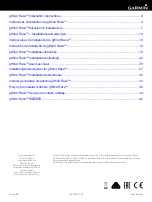
Page 8
GX2200
5.4 COAXIAL CABLE
VHF antennas are connected to the transceiver by means of a coaxial cable
– a shielded transmission line. Coaxial cable is specified by it’s diameter and
construction.
For runs less than 20 feet, RG-58/U, about 1/4 inch in diameter is a good
choice. For runs over 20 feet but less than 50 feet, the larger RG-8X or
RG-213/U should be used for cable runs over 50 feet RG-8X should be used.
For installation of the connector onto the coaxial cable refer to the figure
below.
To get your coax cable through a fitting and into your boat’s interior,
you may have to cut off the end plug and reattach it later. You can do
this if you follow the directions that come with the connector. Be sure
to make good soldered connections.
5.5 DISTRESS AND HAILING (CHANNEL 16)
Channel 16 is known as the Hail and Distress Channel. An emergency may
be defined as a threat to life or property. In such instances, be sure the
transceiver is on and set to CHANNEL 16. Then use the following proce-
dure:
1. Press the microphone push-to-talk switch and say “
Mayday
,
Mayday
,
Mayday
. This is
,
,
” (your vessel’s name).
2. Then repeat once: “
Mayday
,
” (your vessel’s name).
3. Now report your position in latitude/longitude, or by giving a true or
magnetic bearing (state which) to a well-known landmark such as a navi-
gation aid or geographic feature such as an island or harbor entry.
4. Explain the nature of your distress (sinking, collision, aground, fire, heart
attack, life-threatening injury, etc.).
5. State the kind of assistance your desire (pumps, medical aid, etc.).









































